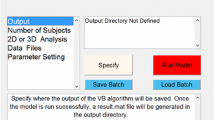Abstract
This paper describes three parallel strategies for Ward’s algorithm with OpenMP or/and CUDA. Faced with the difficulty of a priori modelling of elicited brain responses by a complex paradigm in fMRI experiments, data-driven analysis have been extensively applied to fMRI data. A promising approach is clustering data which does not make stringent assumptions such as spatial independence of sources. Thirion et al. have shown that hierarchical agglomerative clustering (HAC) with Ward’s minimum variance criterion is a method of choice. However, HAC is computationally demanding, especially for distance computation. With our strategy, for single subject analysis, a speed-up of up to 7 was achieved on a workstation. For group analysis (concatenation of several subjects), a speed-up of up to 20 was achieved on a workstation.
This work was supported by a research allocation SANTE 2014 of the Conseil régional d’Auvergne (http://www.auvergne.fr/).
Access this chapter
Tax calculation will be finalised at checkout
Purchases are for personal use only
Similar content being viewed by others
References
Abraham, A., Pedregosa, F., Eickenberg, M., et al.: Machine learning for neuroimaging with scikit-learn. Front. Neuroinformatics 8, 14 (2014)
Calhoun, V.D., et al.: Spatial and temporal independent component analysis of functional MRI data containing a pair of task-related waveforms. Hum. Brain Mapp. 13, 43–53 (2001)
Chang, D., et al.: Compute pairwise Euclidean distances of data points with GPUs. In: Proceedings of the IASTED International Symposium Computational Biology and Bioinformatics (CBB 2008) (2008)
Cordes, D., Haughton, V.M., Arfanakis, K., et al.: Mapping functionally related regions of brain with functional connectivity MR imaging. Am. J. Neuroradiol. 21, 1636–1644 (2000)
Dash, M., Petrutiu, S., Scheuermann, P.: Efficient parallel hierarchical clustering. In: Danelutto, M., Vanneschi, M., Laforenza, D. (eds.) Euro-Par 2004. LNCS, vol. 3149, pp. 363–371. Springer, Heidelberg (2004). https://doi.org/10.1007/978-3-540-27866-5_47
Daubechies, I., et al.: Independent component analysis for brain fMRI does not select for independence. Proc. Nat. Acad. Sci. 106, 10415–10422 (2009)
Gao, X., et al.: Comparison between spatial and temporal independent component analysis for blind source separation in fMRI data. In: 2011 4th International Conference on Biomedical Engineering and Informatics (BMEI), vol. 2, pp. 690–692. IEEE (2011)
Golland, Y., et al.: Data-driven clustering reveals a fundamental subdivision of the human cortex into two global systems. Neuropsychologia 46, 540–553 (2008)
Gonzalez-Castillo, J., et al.: Whole-brain, time-locked activation with simple tasks revealed using massive averaging and model-free analysis. Proc. Nat. Acad. Sci. 109, 5487–5492 (2012)
Kim, S., Ouyang, M.: Compute distance matrices with GPU. Glob. Sci. Technol. Forum (2012). https://doi.org/10.5176/2251-1652_ADPC12.07
Lance, G.N., Williams, W.T.: A general theory of classificatory sorting strategies 1. Hierarchical systems. Comput. J. 9, 373–380 (1967)
Li, Q., et al.: A chunking method for Euclidean distance matrix calculation on large dataset using multi-GPU, pp. 208–213. IEEE (2010)
Matias Rodrigues, J.F., von Mering, C.: HPC-CLUST: distributed hierarchical clustering for large sets of nucleotide sequences. Bioinformatics 30, 287–288 (2014)
McKeown, M.J., Sejnowski, T.J.: Independent component analysis of fMRI data: examining the assumptions. Hum. Brain Mapp. 6, 368–372 (1998)
Olson, C.F.: Parallel algorithms for hierarchical clustering. Parallel Comput. 21, 1313–1325 (1995)
Pedregosa, F., et al.: Scikit-learn: machine learning in Python. J. Mach. Learn. Res. 12, 2825–2830 (2011)
Rasmussen, E.M., Willett, P.: Efficiency of hierarchic agglomerative clustering using the ICL distributed array processor. J. Documentation 45, 1–24 (1989)
Thirion, B., et al.: Which fMRI clustering gives good brain parcellations? Front. Neurosci. 8, 167 (2014)
Zhang, Q., Zhang, Y.: Hierarchical clustering of gene expression profiles with graphics hardware acceleration. Pattern Recogn. Lett. 27, 676–681 (2006)
Author information
Authors and Affiliations
Corresponding author
Editor information
Editors and Affiliations
Rights and permissions
Copyright information
© 2018 Springer International Publishing AG, part of Springer Nature
About this paper
Cite this paper
Angeletti, M., Bonny, JM., Durif, F., Koko, J. (2018). Parallel Hierarchical Agglomerative Clustering for fMRI Data. In: Wyrzykowski, R., Dongarra, J., Deelman, E., Karczewski, K. (eds) Parallel Processing and Applied Mathematics. PPAM 2017. Lecture Notes in Computer Science(), vol 10777. Springer, Cham. https://doi.org/10.1007/978-3-319-78024-5_24
Download citation
DOI: https://doi.org/10.1007/978-3-319-78024-5_24
Published:
Publisher Name: Springer, Cham
Print ISBN: 978-3-319-78023-8
Online ISBN: 978-3-319-78024-5
eBook Packages: Computer ScienceComputer Science (R0)




